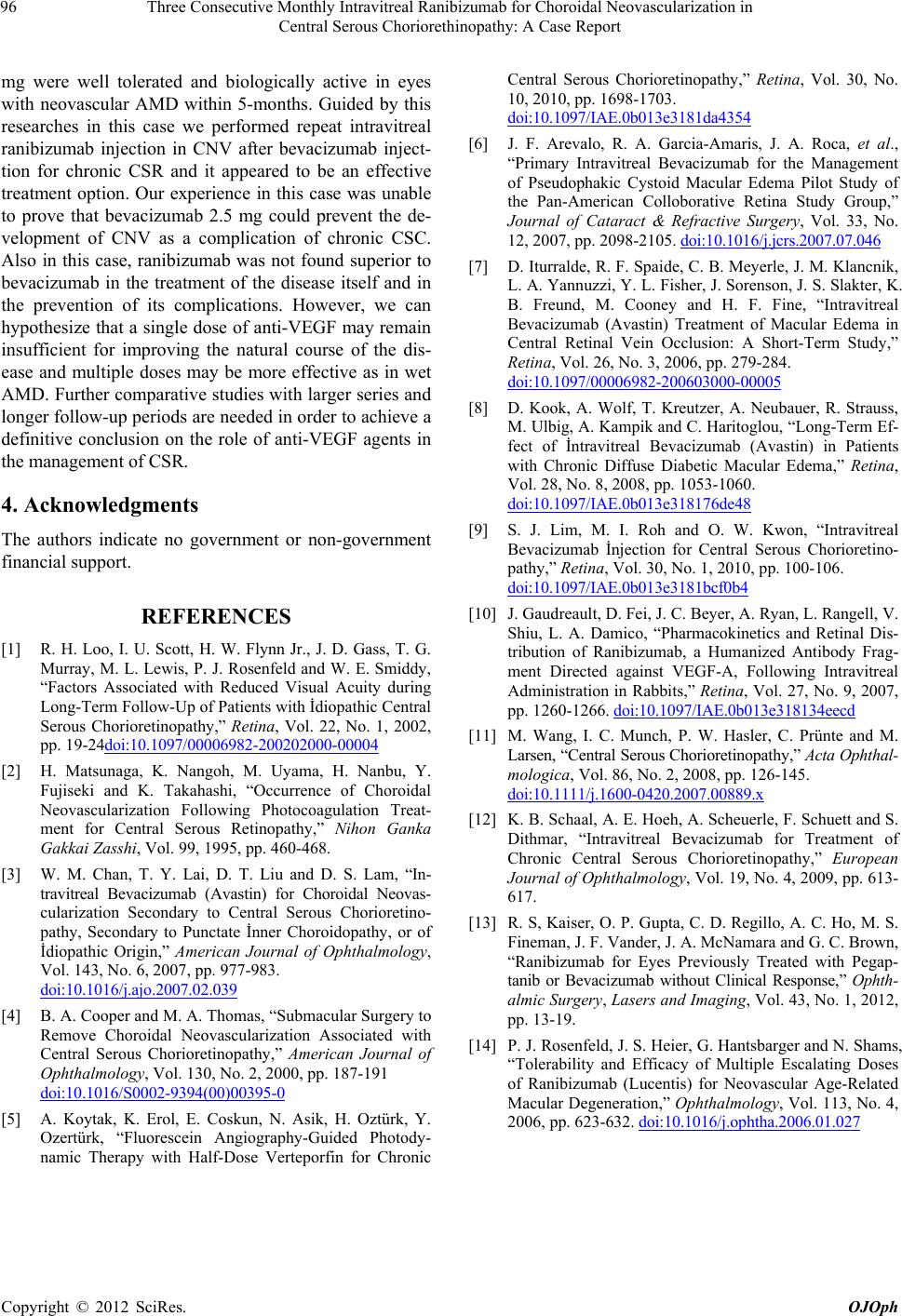
Three Consecutive Monthly Intravitreal Ranibizumab for Choroidal Neovascularization in
Central Serous Choriorethinopathy: A Case Report
96
mg were well tolerated and biologically active in eyes
with neovascular AMD within 5-months. Guided by this
researches in this case we performed repeat intravitreal
ranibizumab injection in CNV after bevacizumab inject-
tion for chronic CSR and it appeared to be an effective
treatment option. Our experience in this case was unable
to prove that bevacizumab 2.5 mg could prevent the de-
velopment of CNV as a complication of chronic CSC.
Also in this case, ranibizumab was not found superior to
bevacizumab in the treatment of the disease itself and in
the prevention of its complications. However, we can
hypothesize that a single dose of anti-VEGF may remain
insufficient for improving the natural course of the dis-
ease and multiple doses may be more effective as in wet
AMD. Further comparative studies with larger series and
longer follow-up periods are needed in order to achieve a
definitive conclusion on the role of anti-VEGF agents in
the management of CSR.
4. Acknowledgments
The authors indicate no government or non-government
financial support.
REFERENCES
[1] R. H. Loo, I. U. Scott, H. W. Flynn Jr., J. D. Gass, T. G.
Murray, M. L. Lewis, P. J. Rosenfeld and W. E. Smiddy,
“Factors Associated with Reduced Visual Acuity during
Long-Term Follow-Up of Patients with İdiopathic Central
Serous Chorioretinopathy,” Retina, Vol. 22, No. 1, 2002,
pp. 19-24doi:10.1097/00006982-200202000-00004
[2] H. Matsunaga, K. Nangoh, M. Uyama, H. Nanbu, Y.
Fujiseki and K. Takahashi, “Occurrence of Choroidal
Neovascularization Following Photocoagulation Treat-
ment for Central Serous Retinopathy,” Nihon Ganka
Gakkai Zasshi, Vol. 99, 1995, pp. 460-468.
[3] W. M. Chan, T. Y. Lai, D. T. Liu and D. S. Lam, “In-
travitreal Bevacizumab (Avastin) for Choroidal Neovas-
cularization Secondary to Central Serous Chorioretino-
pathy, Secondary to Punctate İnner Choroidopathy, or of
İdiopathic Origin,” American Journal of Ophthalmology,
Vol. 143, No. 6, 2007, pp. 977-983.
doi:10.1016/j.ajo.2007.02.039
[4] B. A. Cooper and M. A. Thomas, “Submacular Surgery to
Remove Choroidal Neovascularization Associated with
Central Serous Chorioretinopathy,” American Journal of
Ophthalmology, Vol. 130, No. 2, 2000, pp. 187-191
doi:10.1016/S0002-9394(00)00395-0
[5] A. Koytak, K. Erol, E. Coskun, N. Asik, H. Oztürk, Y.
Ozertürk, “Fluorescein Angiography-Guided Photody-
namic Therapy with Half-Dose Verteporfin for Chronic
Central Serous Chorioretinopathy,” Retina, Vol. 30, No.
10, 2010, pp. 1698-1703.
doi:10.1097/IAE.0b013e3181da4354
[6] J. F. Arevalo, R. A. Garcia-Amaris, J. A. Roca, et al.,
“Primary Intravitreal Bevacizumab for the Management
of Pseudophakic Cystoid Macular Edema Pilot Study of
the Pan-American Colloborative Retina Study Group,”
Journal of Cataract & Refractive Surgery, Vol. 33, No.
12, 2007, pp. 2098-2105. doi:10.1016/j.jcrs.2007.07.046
[7] D. Iturralde, R. F. Spaide, C. B. Meyerle, J. M. Klancnik,
L. A. Yannuzzi, Y. L. Fisher, J. Sorenson, J. S. Slakter, K.
B. Freund, M. Cooney and H. F. Fine, “Intravitreal
Bevacizumab (Avastin) Treatment of Macular Edema in
Central Retinal Vein Occlusion: A Short-Term Study,”
Retina, Vol. 26, No. 3, 2006, pp. 279-284.
doi:10.1097/00006982-200603000-00005
[8] D. Kook, A. Wolf, T. Kreutzer, A. Neubauer, R. Strauss,
M. Ulbig, A. Kampik and C. Haritoglou, “Long-Term Ef-
fect of İntravitreal Bevacizumab (Avastin) in Patients
with Chronic Diffuse Diabetic Macular Edema,” Retina,
Vol. 28, No. 8, 2008, pp. 1053-1060.
doi:10.1097/IAE.0b013e318176de48
[9] S. J. Lim, M. I. Roh and O. W. Kwon, “Intravitreal
Bevacizumab İnjection for Central Serous Chorioretino-
pathy,” Retina, Vol. 30, No. 1, 2010, pp. 100-106.
doi:10.1097/IAE.0b013e3181bcf0b4
[10] J. Gaudreault, D. Fei, J. C. Beyer, A. Ryan, L. Rangell, V.
Shiu, L. A. Damico, “Pharmacokinetics and Retinal Dis-
tribution of Ranibizumab, a Humanized Antibody Frag-
ment Directed against VEGF-A, Following Intravitreal
Administration in Rabbits,” Retina, Vol. 27, No. 9, 2007,
pp. 1260-1266. doi:10.1097/IAE.0b013e318134eecd
[11] M. Wang, I. C. Munch, P. W. Hasler, C. Prünte and M.
Larsen, “Central Serous Chorioretinopathy,” Acta Ophthal-
mologica, Vol. 86, No. 2, 2008, pp. 126-145.
doi:10.1111/j.1600-0420.2007.00889.x
[12] K. B. Schaal, A. E. Hoeh, A. Scheuerle, F. Schuett and S.
Dithmar, “Intravitreal Bevacizumab for Treatment of
Chronic Central Serous Chorioretinopathy,” European
Journal of Ophthalmology, Vol. 19, No. 4, 2009, pp. 613-
617.
[13] R. S, Kaiser, O. P. Gupta, C. D. Regillo, A. C. Ho, M. S.
Fineman, J. F. Vander, J. A. McNamara and G. C. Brown,
“Ranibizumab for Eyes Previously Treated with Pegap-
tanib or Bevacizumab without Clinical Response,” Ophth-
almic Surgery, Lasers and Imaging, Vol. 43, No. 1, 2012,
pp. 13-19.
[14] P. J. Rosenfeld, J. S. Heier, G. Hantsbarger and N. Shams,
“Tolerability and Efficacy of Multiple Escalating Doses
of Ranibizumab (Lucentis) for Neovascular Age-Related
Macular Degeneration,” Ophthalmology, Vol. 113, No. 4,
2006, pp. 623-632. doi:10.1016/j.ophtha.2006.01.027
Copyright © 2012 SciRes. OJOph